Day two and we are checking out of the hotel and in the car to Telavi. A quick word about getting around in Georgia: Bolt. There’s taxis and busses and trains and so on, even a subway, but Bolt is cheap and good. We took one from Tbilisi to Telavi, a two-hour drive, for 133 Lari (or “Larrys” as I called them) or about 50 bucks. I guess there’s a bus that’s cheaper but we’re only around for a week so no time to lose and the ride was spectacular.

I’m afraid you can’t see the sign very well but it was raining and the car was going fast but that’s the sign for George Bush Boulevard. He was a popular chap in Georgia at one time, helping them get a bit closer to NATO membership or something. Didn’t do them much good when Russia invaded though.
The countryside reminded me of my native country Victoria, rolling green pastureland. The difference is that they don’t have paddocks or fences, I guess the sheep just go wherever. Our driver took the ‘windy’ route. That is, it’s a twisty road (and was windy too) and ascended over a pass, quite a high one. We did stop at the top, which was high enough for my ears to pop but I don’t have any photos as we were in the clouds.
Telavi is a nice regional centre in the wine country. We stayed at the Holiday Inn, here’s the view from our room:


Telavi comes with its own castle ruin. There’s a statue of the local lord on a horse and bunch of walls.
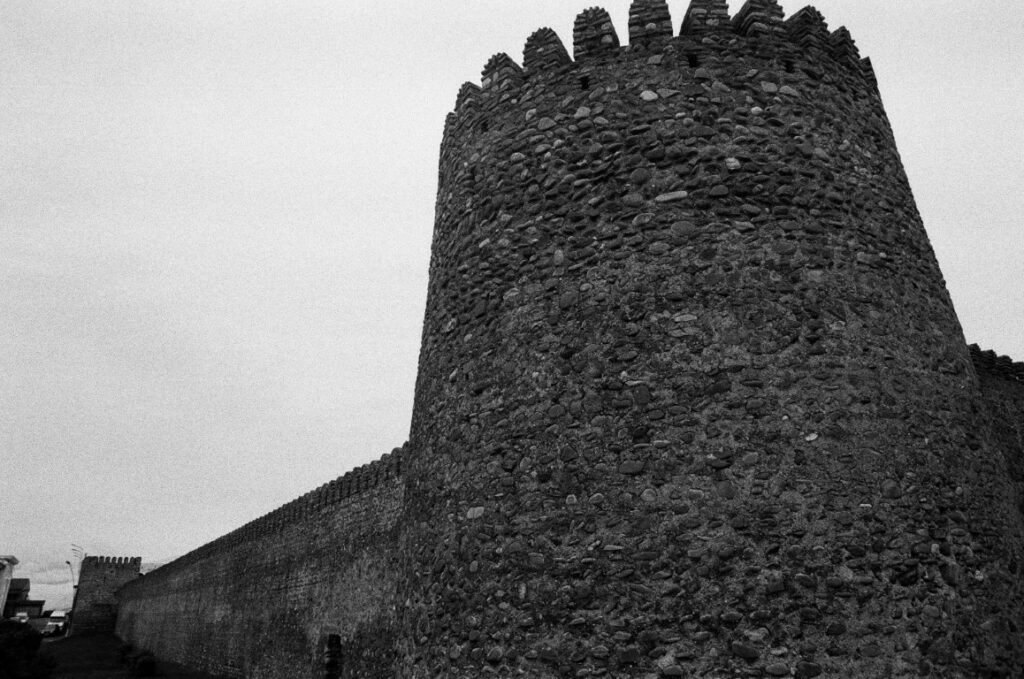
Georgia is in a part of the world where you need stout fortifications. According to Wikipedia, Telavi boasts fortifications from four distinct periods, we only saw this one.
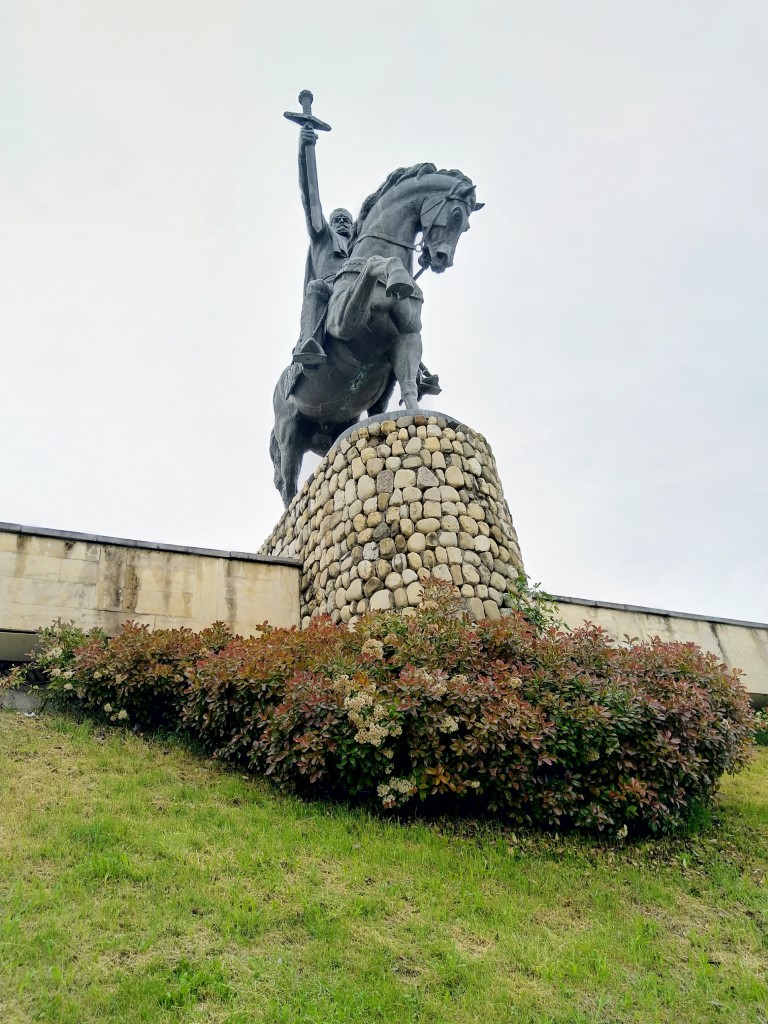
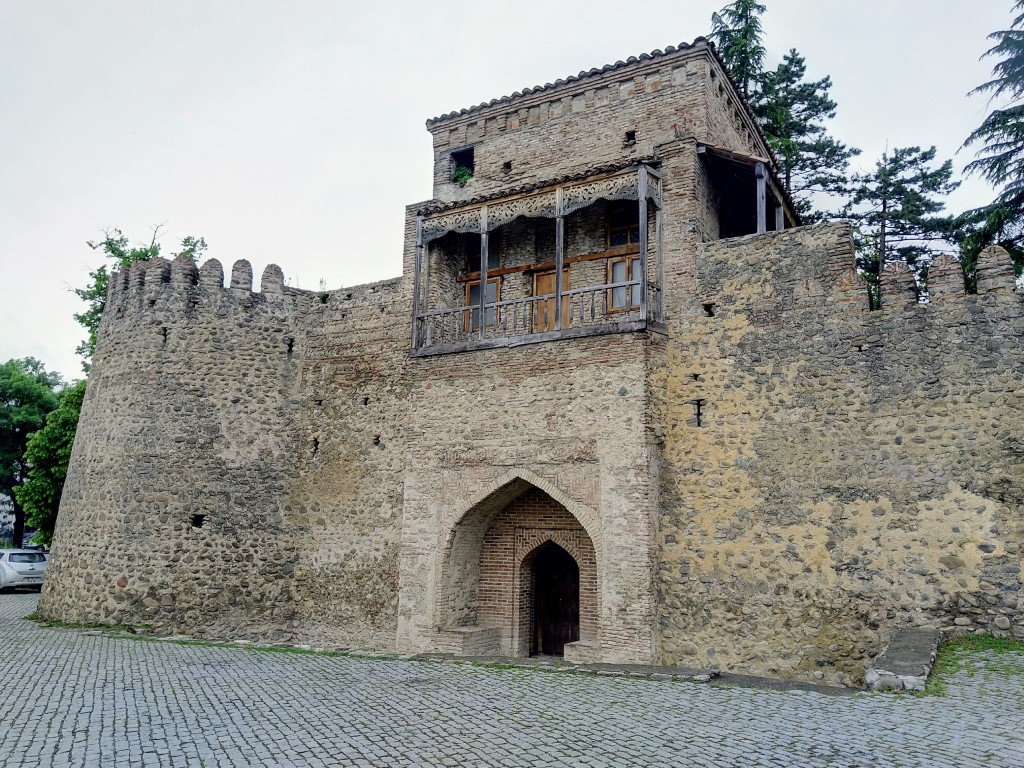
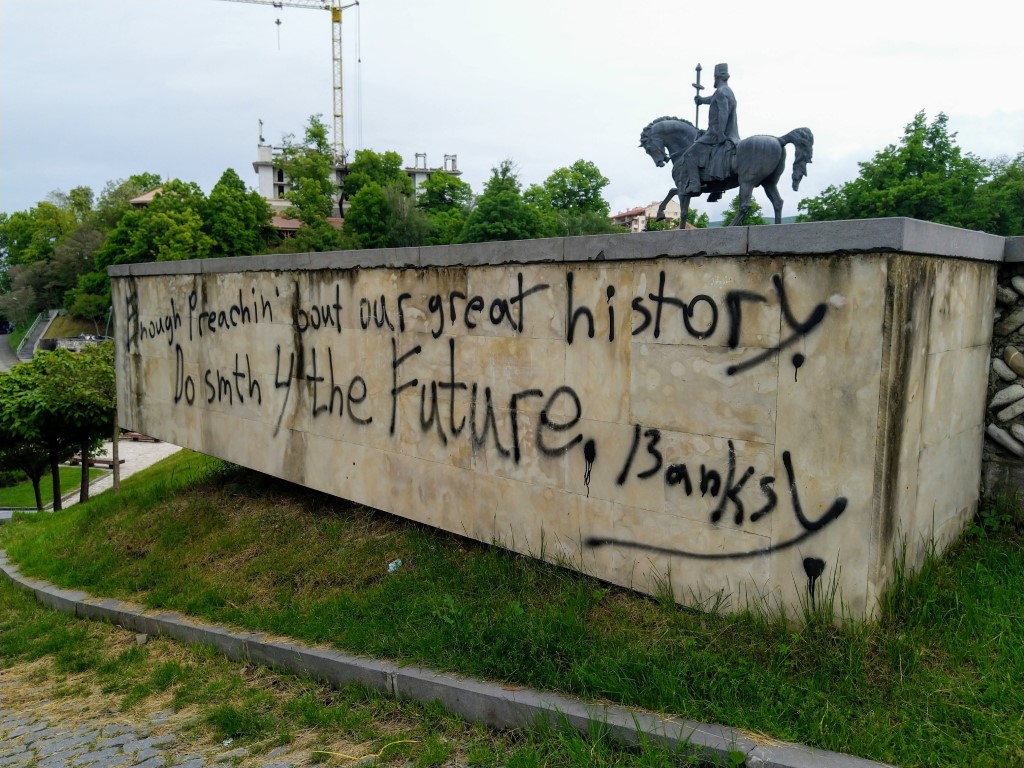
The trouble is that, Telavi is a bit shit. We checked out the market and it puts me in the mind of Cambodia. Luckily there was a couple of fancy restaurants next door to the hotel. Cue Sachie’s introduction to Cha Cha.
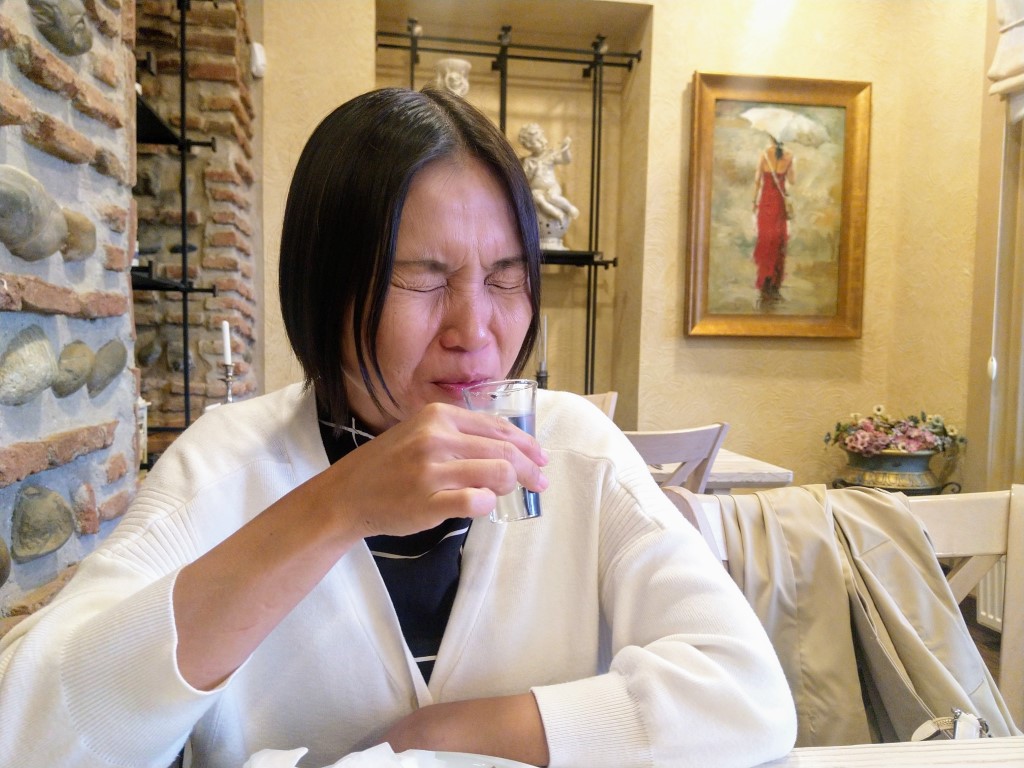
Yep, Georgia may be the home of wine but they make ‘cha cha’ with the leftovers. It can be most closely related to grappa and is the firewater that’s made from the leavings from winemaking. Needless to say, we slept well.

Telavi may have a great nightlife but I wouldn’t know because we had an early start the next day — winery tour. We hired a driver by the name of Mamuka a couple of years ago but the trip got postponed due to covid. Now we had him behind the wheel for the whole day, ferrying us from winery to winery. But first, culture.

Alexander Chavchavadze used to live here. He was an imperial official and an admired poet, so they gave him this nice house. Not sure why it’s out here in the middle of nowhere, many hours from the city but it is set in lovely grounds. Inside is well preserved but I can’t show you as you’re not allowed to take photographs.

The house is a fine example of Caucasian/Russian imperial architecture and they have a scriptorium that has stunning, very old manuscripts on display. But this isn’t a history tour and the only culture we were interested in is yeast in a wine vat.

Do you about traditional Georgian wine? No? Well listen carefully, pleb. The Georgians claim that they’ve been fermenting grapes for 8,000 years. They sold wine to the Romans and everyone else before and since. Their method is unique: they bury massive clay pots up to the neck in soil, crush up the grapes and toss it all in, seal it up and wait a few months. Then it’s tapping time and they use a big dipper to get the wine out. Wine may be moved to other pots above or below ground for maturation but the basic method is: hole + grapes + time = wine.
After you get the wine out you send your cousin into the pot to clean it out, and to make the afore-mentioned cha-cha. The chap in the pot is asked to sing while he works so you can tell when he passes out from the fumes. Maybe the tie a rope around his waist as well?

So the first winery sat us in the garden and started pulling corks. This winery, like most in Georgia, produce wine using traditional methods as well as what they call the ‘European method’. The traditional method retains skins, stems, dirt, old bottle tops and someone’s glasses that they’re probably looking for throughout the fermentation process, proper tough-guy wine. Whereas under the poofy ‘European method’ they take that stuff out at some point. The result is that traditional wines are heavy with tannins and rich, complex flavours (turpentine? paint stripper?) and the stainless-steel vat club are lighter and closer to what’s expected by the international palate. The good news is that Georgia takes an innovative approach to both, helped along by their massive menu of grape varieties. Have a look at the awards plastering the walls of this second winery.

We did buy bottles at each winery, in this one we picked up one of ‘orange’ wine. Yep, there’s white, red and orange in Georgia and it really does have an orange hue. I really wanted the orange one we tasted as it is an excellent example of stony or flinty flavours in a wine that we so rarely see in our new-world wines.


They also have a fine cha-cha, 99% guaranteed not to make you blind or spontaneously combust. I believe these are bohemian glasses but I don’t really care.
I assume that by this time we were due lunch but for the life of me I can’t remember eating anything or where it was. Miss Sachie informs me that we did in fact dine at a winery at which we were the only guests and was mostly under construction. Oh well.
Our next stop was the party house, also known as the Numisi Cellar Museum. Here’s the cellar:

The museum part refers to the sizable collection of soviet-era appliances, like radios, TVs and so on. Some fantastic typewriters.


It was at this place that we first got a good look at the Qvevris, the earthenware pots in which the wine is made:


I’m not sure of these were in use at the time but I don’t think so. After a look around we were invited to a vaulted and semi-sunken hall with a fine fireplace at one end. On the table we found a jug of wine, plenty of cha-cha and some salty bread and cheese.

Miss Sachie and I are big drinkers and lovers of cheese. Perfect! The Georgian cheese is salty and full of bubbles so with salty bread they demand a whistle-wetter. Oh dear, the red is a bit sweet, better try the cha-cha.
Well, that was enough for me. The kerosine cha-cha sat in my stomach like an old truck-tyre and put me off the idea of putting anything else in there. The museum would be magnificent with a tour bus full of people, all necking sweet wine and cheap moonshine next to a roaring fire, they even have a duck pond outside to vomit into. Sadly, it was just the two of us, but we did our best to get into the spirit.

This rather finished us for the day and we were unable to enjoy drinks at the next stop, which was a shame because this was the place where you can drink right out of the Qvevri, with a dipper of course.
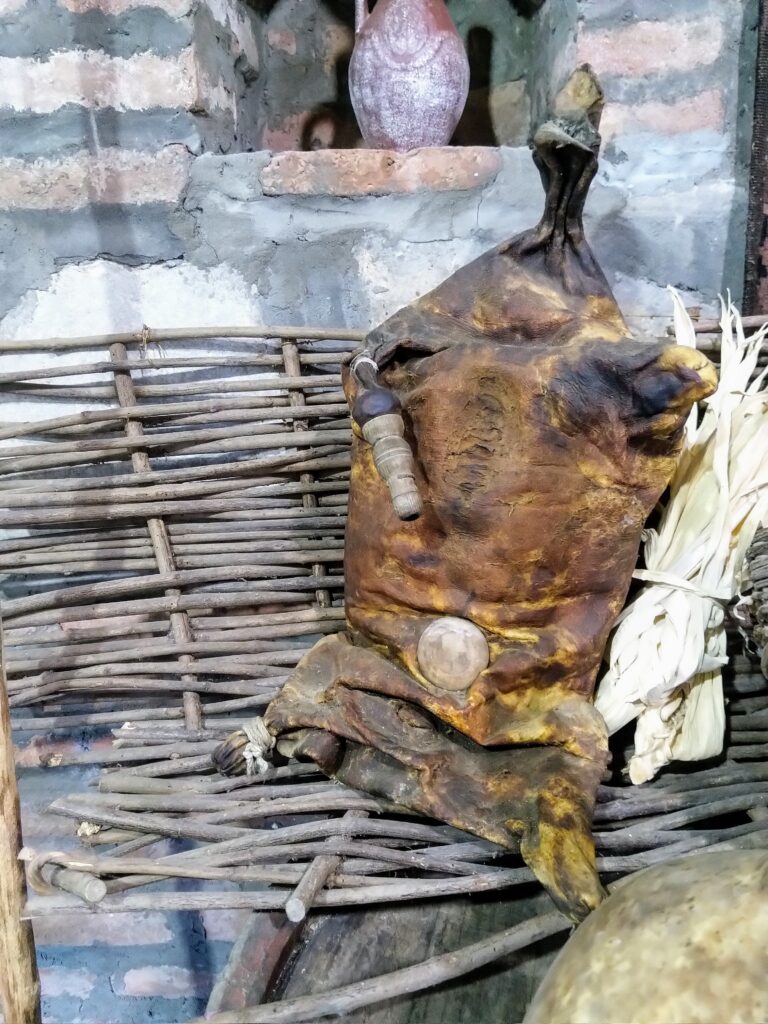
It was a shame as this was a very nice, small winery that looked great in the late-afternoon sunlight. They were even making some of Georgia’s favourite treat:

No, it’s not poo on a string, that’s churchkela, nuts covered in grape juice thickened with flour. The string is dipped in the mix, left to dry and dipped again like you’re making a candle. The result is delicious and cheap. We didn’t get any at this stop but stocked up back in Tbilisi.
By now Mamuka was warming to us a bit. He normally drives around tourists and his English is pretty good but Covid had done its work on the Georgian tourism market and he was topping up his business by taking on some side work by collecting coins from charitable donation boxes around the countryside. He is concerned that he’s carrying around a lot of money and the company won’t give him a gun to protect himself from bandits. I worked out that he’d be carrying at most around $500 so if he needs a gun to stop people hijacking him on the road things must be a bit grim in country Georgia. Not sure how that compares to US-Georgia but I expect someone may shoot you for $500 in change there too.
Now the sun was getting low and we couldn’t drink any more. But no! There was the mountain village of Sighaghi, a charming hamlet of hills and steep driveways. It has a wall.
There’s a wonderful view of the snow-capped Caucus mountains there and it really is a beautiful part of the world. Really lets you know that you’re in Europe. Being a lad from country Victoria we don’t have old castles or interesting ruins, although to be fair I’ve seen cave paintings tens of thousands of years old there, but it’s not the same.
Being Covid-times the place was very quiet but there are signs that this was once a bustling backpacker-colony.

See that shop through the gate? They sell tourist nick-nacks and socks. Wonderful socks displayed up and down the wall. I bought some off the old lady knitting in the doorway next to the shop and she sold me the scratchiest, itchiest, hardest woollen socks have have ever worn in my life. Turns out she lives next to the shop and has nothing to do with it. Down the road is carpet-mart.

It’s a beautiful and ancient town and I’m so glad that we could visit, I’d like to go and stay there one day.

Time to go home. It was proper dark now and the roads were windy and long. It was about now that Mamuka regaled us with tales of countryside living, of drinking Cha-Cha in winter but mostly about his recent divorce and how much he misses his daughter. The newly divorced man is prone to explaining, in excruciating detail, the circumstances of his breakup. I know this because I have been that man. Can’t blame the chap, we’re all prone to it but as I have my current main squeeze in the back passenger seat with me so I can’t top his story or tell him to take a teaspoon of cement and harden the fuck up.
We’d brought some gifts from Thailand for him, being decent folk (well Sachie is). Somehow we gave them to him before getting dropped off and he stopped where his daughter lives so he could give them to her. He’s a very decent bloke and a generous one as well. I wish him all the best and hope to see him next time we visit.
Mamuka dropped us off at the Holiday Inn and we were completely rooted and went to bed. Thus ends part II.

2 thoughts on “Dan Went down to Georgia: Day II”